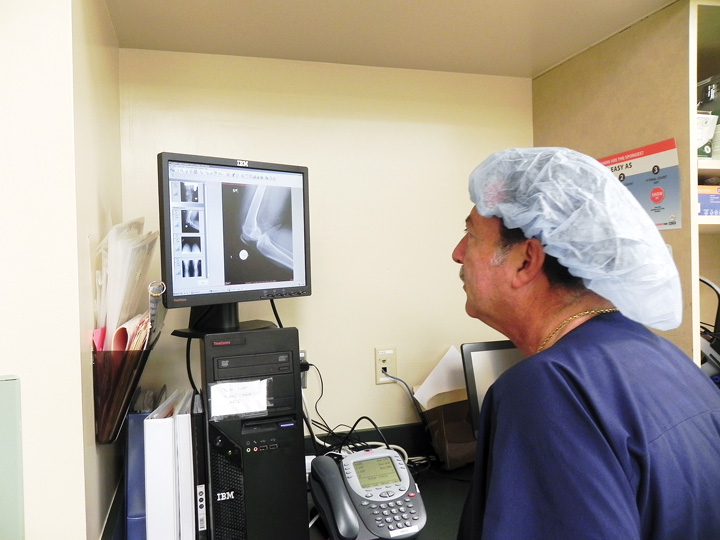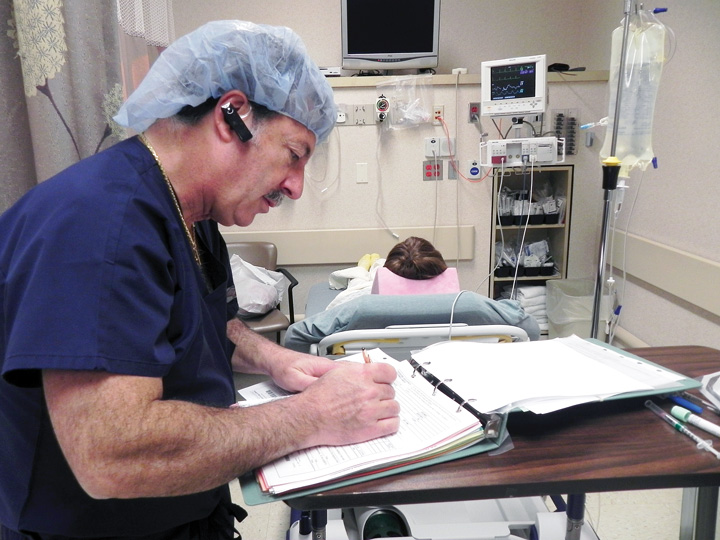- Home
- Article
The Growth of Personalized Joint Replacements
By: Adolph V. Lombardi, Jr., MD, FACS
Published: 10/3/2024
Custom implants, precise cutting guides and 3D printing combine to provide patients with individualized TKA procedures.
The phrase “personalized joint replacements” is used to mean different things. In each case, however, a mix of modern technology is utilized in the quest to achieve better outcomes.
• Custom implants. This approach begins with obtaining a specific computed topography (CT) scan of the patient preoperatively in order to construct a 3D model of their knee. It must be a complete CT of the knee and a couple of slices through the hip and through the ankle to determine limb alignment. The surgeon then makes a variety of decisions preoperatively about various parameters. They can align the knee to follow mechanical alignment, in which a line from the center of the femoral head would pass through about the center of the knee and the center of the ankle, which is the approach the majority of surgeons in the U.S. still follow.
There’s also a new concept called kinematic alignment, which involves essentially resurfacing the knee by removing part of the bone and replacing it with metal. Even if the tibial component is in a little bit of varus, surgeons can cut the bone and leave the tibia in that amount of respective varus. A surgeon can use mechanical alignment, kinematic alignment or set restrictions for the upcoming case. For example, a surgeon can decide they don’t want to cut a patient’s tibia in any more than three degrees of varus. Or, with a patient whose preoperative alignment is varus, they can set a parameter that would leave them with one or two degrees of varus, because they don’t want to straighten the patient all the way to neutral in order to limit the amount of soft tissue releases performed during the procedure.
• Creating a 3D model. This approach involves knowing the exact size and shape of the patient’s femur and tibia in order for the manufacturer to create a custom implant for the surgeon that perfectly matches the patient’s bone at the resection level. I recently heard of an example of a surgeon who ordered femur and tibial components customized for a very tall, large patient. The surgeon realized after looking at the patient’s bony anatomy that no implant on the market would be large enough to cover the end of his distal femur and the upper part of his tibia, so they went the custom route.
Custom implants also have the ability to incorporate a different-sized thickness of plastic on the medial side of the knee versus the lateral side. Why is that important? Well, the native knee is looser laterally than it is medially, and that laxity is stabilized by the contours of the menisci and the fact that knees have anterior and posterior cruciate ligaments (ACL and PCL), that guide and captured motion. Once the surgeon removes the ACL and the PCL, it's game over – kinematics are no longer the same. The surgeon depends on the polyethylene for control, enabling them to do a little thicker poly laterally than they do medially in order to stabilize the knee and better balance it.

• Surgeons set the defaults. When preparing the specifics for surgical guides, physicians can set any number of defaults. They can say they don’t want to cut the tibia in any more than three degrees of posterior slope, or that they don’t want to cut the tibia in more than three degrees of varus. They could make sure that the femur will be fully captured. They could say they want to rotate the femoral component so it's aligned with the transepicondylar axis or the anterior-posterior (AP) axis. Or they just might want to take an equal amount of bone from the posterior condyles. These are all things the surgeon can decide preoperatively and tweak to how they feel comfortable performing the knee replacement.
The knee in the box. The surgeon receives a set of guides that will fit precisely onto the patient’s bones. The manufacturer has created the femoral contour in three dimensions, then it creates a mirror image of that exterior contour that will sit precisely on the end of the femoral bone. Once it grasps the femoral bone, it has holes in it to place pins that hold the guide while the surgeon cuts the end of the distal femur. There are also two holes to pin in place what we call the four-in-one block that guides the anterior, the posterior and the chamfer cuts. This eliminates the need to run a rod up the femoral canal at this point and measure angles. Surgeons don’t need to guesstimate where the transepicondylar or the AP axes are because that has been determined from the preoperative CT scan. And there’s no need to put drill holes in the femur or have a robot with the arrays because it’s all been done beforehand. Likewise, on the tibia, the surgeon lays the custom guide/jig on the front of the tibia, it locks onto the tibia, they pin it in place, and then can make the bone cuts.
These exact type of guides were developed more than a decade ago. A preoperative MRI or CT scan was taken to make the guides, and surgeons used them to implant off-the-shelf components. The latest wrinkle is the addition of the size-specific, perfectly matched implants.
• Personalized robotics alignment. In this context, when people use the term “personalized alignment” in robotic knee replacement, they mean the surgeon drills two holes in the femur and two holes in the tibia and attaches arrays to the bones. The bones are then visualized by a high-definition camera that provides brilliant three-dimensional views of the surgical area. The surgeon determines on the screen whether the patient is lying in neutral, varus or valgus alignment. The system actually tells them the degrees and then they can stress the bones medially and laterally and see how much the ligaments give. The surgeon can take the knee through a range of motion to get a representation of how much the knee opens, medially and laterally, throughout the whole arc of motion.

Next the surgeon considers that data to decide what they want to input to get a balanced knee. To make the ligaments equally taut, they must create gaps that are at least 19 millimeters on the medial and lateral sides, both in flexion and extension. Some surgeons tweak this just a bit. On the screen, they can move the implant up or down, rotate the femur and, therefore, can change the size of the gaps in flexion. In extension, they can input more or less varus or valgus, which will change the size of the gaps. They can do the same thing on the tibia. They can put the tibia in a couple degrees of varus or valgus, or more slope or less slope, and get the patient a balanced gap in flexion and extension of about 19 millimeters. This is considered a personalized procedure because physicians are taking the patient’s individual data and using them to create the gaps.
In these procedures, surgeons are not worried about where the alignment rod passes. They don’t care if you draw a line that it should pass through the center of the knee, which has been the historical dogma. The thought has been that to have equal loads in the medial and lateral tibial plateau, the vector force should fall right through the middle or just slightly to the medial side of the knee.
It’s unknown whether personalized technology will change functional recovery or postoperative outcome scores. We have no long-term data on whether these will be viable long-term options. We do know that many, many implants cemented in using the mechanical alignment approach more than 20 years ago continue to function just fine.
Some robotic platforms have an automated program with which you can create mapping guides and a surgical plan on the spot. Thise program allow you to make slight changes to them in real time. While these approaches all have benefits, it’s very hard for me to believe that they will become the norm. The question is whether the manufacturers will be able to drive down the cost far enough to make sense for larger scale use in outpatient settings. OSM
Promising research and early use of high-tech devices provide a glimpse into what could be the norm of same-day total knee replacements in coming years.
The FDA first approved smart knee implants in 2021, essentially a fitbit inside the body of knee replacement recipients to monitor how they’re doing.
The implant has a small stem with a sensor on its base that allows a patient and their surgical teams to know how fast the patient is walking, how far they’re walking each day and the new knee’s range of motion while walking. There is a base station that stays on the patient’s nightstand.
The stem contains an accelerometer and goniometer and the sensor collects data as the patient walks for weeks and months postoperatively. Using Wi-Fi technology, the data collected in vivo by the stem is linked to the base station, which transmits it to a HIPPA-compliant cloud-based platform that the patient and care team can access.
Monitoring gait speed, step cadence, stride length, range of motion and step counts has twofold benefits, according to orthopedic surgeon Tyler Steven Watters, MD, who spoke with Outpatient Surgery Magazine after he performed the first knee replacement using a smart implant in North Carolina in 2022. The device allows patients to see what their baseline is preoperatively and then track their progress through their recovery with real objective data that is literally coming from inside of them.
The battery should last about 10 years as long as the base station remains plugged in. The station can collect data for up to 30 days before it must transfer it to the cloud platform, so a patient could go on a two-week vacation and return and review all their walking data from the trip.
The technology provides the care team objective data for measuring how patients are progressing and allows patients to take a more active and personalized role in their recovery, Dr. Watters says.
In addition to the personalized data for each patient, the cumulative data, once aggregated and de-identified, could help the orthopedic surgical community learn what should be expected from their patients postoperatively, says Dr. Watters. Knee replacement outcomes vary widely — some people are walking three miles a day six weeks out, while others are only able to walk a half-mile a day. The in vivo data will help surgeons come up with reasonable expectations about the progress patients in various demographics should be making over time as they continue to recover and normalize.
—Outpatient Surgery Editors
.svg?sfvrsn=be606e78_3)
.svg?sfvrsn=56b2f850_5)